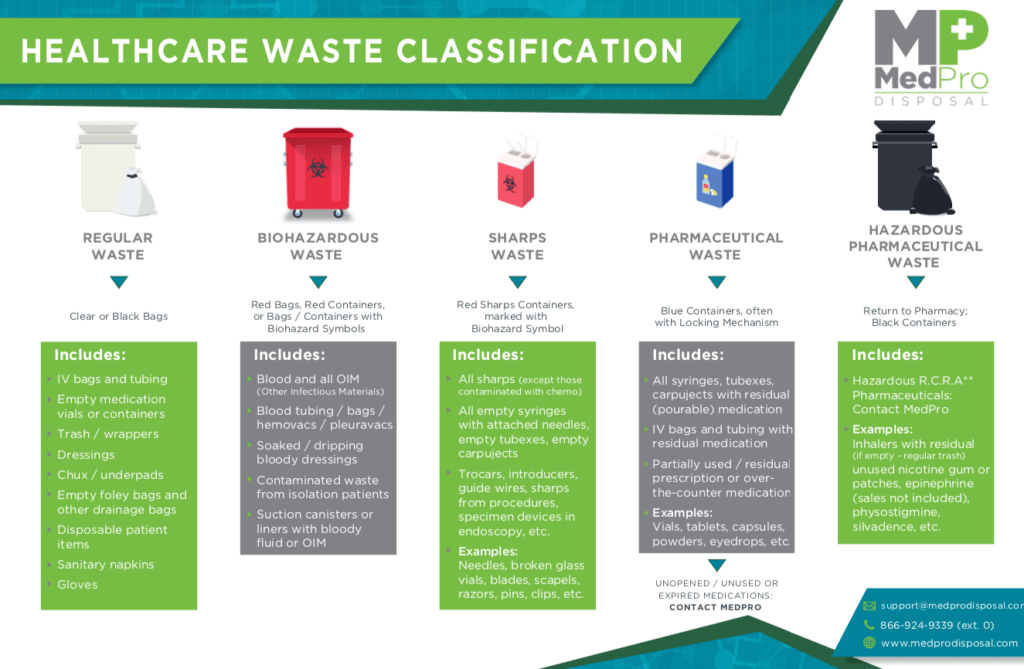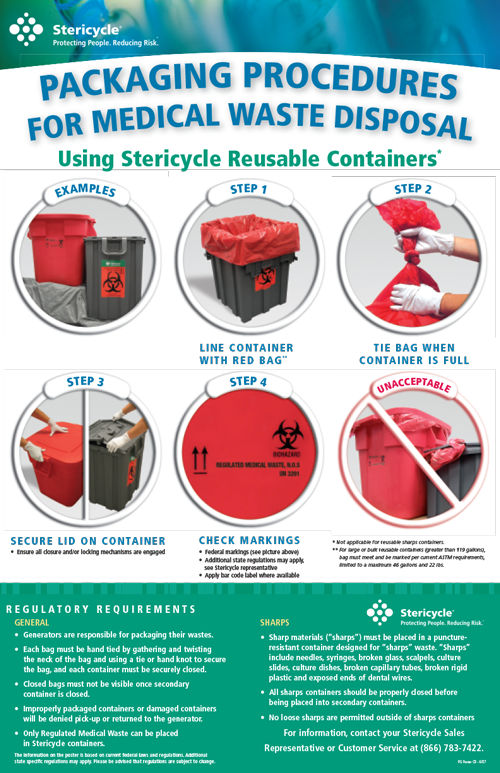Specialist Medical Waste Disposal Service: Guarding Your Center and Community
Ideal Practices for Medical Waste Monitoring
Clinical waste management is an important facet of medical care centers' procedures to ensure the safety of individuals, personnel, and the atmosphere. Carrying out ideal techniques in clinical waste administration is important to decrease the threats connected with contaminated materials. This consists of correct partition and categorization of waste, ensuring its safe storage and labeling, sticking to governing standards, and using efficient disposal methods. By following these best practices, medical care centers can lower the possibility for infections, injuries, and air pollution brought on by incorrect handling and disposal of medical waste. This introduction intends to give a review of the value of finest methods for medical waste administration and the subsequent areas will certainly dig into each technique in detail.
Segregation and Classification
In the field of clinical waste management, correct segregation and classification are necessary techniques for ensuring the risk-free and effective disposal of healthcare-related products. Clinical waste is produced from numerous sources, consisting of medical facilities, facilities, labs, and various other healthcare centers. It is composed of a large range of items, such as needles, syringes, bandages, handwear covers, and pharmaceutical waste.
Partition involves the methodical splitting up of different sorts of clinical waste based upon their qualities and prospective threats. This process assists to stop cross-contamination and guarantees that each sort of waste is taken care of appropriately. Sharps waste, such as needles and blades, ought to be put in puncture-resistant containers to protect against injuries and the spread of infectious illness. Likewise, transmittable waste, such as blood-soaked plasters or societies, should be segregated and treated individually to decrease the threat of spreading out pathogens.
Classification is the process of categorizing clinical waste into various categories based on its possible hazards. WasteX Medical Waste Disposal. These categories might consist of contagious waste, harmful waste, pharmaceutical waste, and basic waste. By classifying waste, medical care centers can establish the proper disposal approaches and make certain conformity with local policies and guidelines
Appropriate segregation and classification of medical waste not just secure the health and safety and security of health care employees and the public but likewise add to the total efficiency and performance of waste administration. It reduces the danger of accidents, lessens environmental effects, and promotes accountable waste disposal methods.
Correct Storage and Classifying
To guarantee the effective and risk-free disposal of medical waste, medical care centers must stick to appropriate storage space and labeling methods. Correct storage space and labeling play a vital function in maintaining the honesty of medical waste management systems and protecting the health and wellness and safety and security of healthcare employees, people, and the general public.
When it concerns storage, it is vital to have assigned areas especially developed for various kinds of clinical waste. These areas must be protected, well-ventilated, and equipped with appropriate containers that fulfill regulatory requirements. Partition and categorization of waste should likewise be considered to avoid cross-contamination and potential hazards.
In addition, correct labeling is crucial for efficient waste administration - medical waste disposal. Each container ought to be clearly classified with the ideal signs, color-coding, and info about the waste it contains.
Normal surveillance and assessment of storage areas and containers are essential to identify any kind of problems or infractions. Staff needs to be educated on proper storage space and labeling techniques, highlighting the significance of compliance with procedures and regulations.
Safe Transportation and Handling
Guaranteeing the safe and correct transport and handling of medical waste is essential for keeping the stability of waste management systems and guarding the health and wellness and safety of all entailed. Medical waste, that includes products contaminated with transmittable materials, drugs, and other unsafe compounds, must be delivered in a manner that stops leaks, spills, and prospective contamination.
To achieve risk-free transportation and handling, a number of ideal methods should be adhered to. It is important to make use of leak-proof and puncture-resistant containers that are especially created for clinical waste. These containers should be appropriately secured and classified to stop any unintended direct exposure or messing up. Additionally, waste needs to be set apart based upon its nature and kind to stop cross-contamination.
During transport, it is essential to make certain that waste containers are safely fastened and saved in a stable way. Automobiles used for moving medical waste should be furnished with proper safety and security functions, such as spill containment systems, to reduce the danger of any kind of leakages or spills (medical waste removal service). Chauffeurs must receive training on correct handling and emergency situation feedback treatments to efficiently resolve any type of unpredicted cases
Additionally, the transport and handling of clinical waste ought to adhere to all relevant laws and standards stated by local, state, and government authorities. Routine examinations and audits ought to be carried out to evaluate conformity and recognize any kind of areas for renovation.

Compliance With Regulatory Guidelines
Maintaining conformity with regulative guidelines is essential for efficient clinical waste management. These standards are implemented to shield public wellness and the setting by making certain that medical waste is effectively handled, treated, and disposed of. medical waste removal. Compliance with regulative guidelines assists to stop the spread of transmittable illness, decrease prospective risks, and lower the general influence of medical waste on the setting
To achieve conformity, healthcare facilities have to stay educated about the certain regulations regulating clinical waste management in their jurisdiction. These laws may differ from nation to country, and even within various states or areas. It is essential for medical care facilities to have an extensive understanding of these standards and to implement suitable approaches and protocols to make sure conformity.
One trick aspect of compliance is the appropriate partition and labeling of various sorts of medical waste. This consists of dividing sharps from various other waste, as well as categorizing waste based on its prospective threats. Healthcare facilities should likewise make certain that clinical waste is saved in appropriate containers and that these containers are appropriately classified and secured.
Additionally, compliance with regulative guidelines needs health care centers to develop correct training and education and learning programs for team members involved in medical waste administration - WasteX Medical Waste Disposal. This includes providing training on waste segregation, handling, and disposal procedures, as well as the correct use individual safety devices
Routine tracking and audits are also official source vital to guarantee continuous compliance with governing guidelines. This involves performing routine assessments of waste storage areas, recording waste administration procedures, and keeping documents of waste disposal.
Reliable Disposal Techniques
Healthcare centers need to employ reliable disposal techniques for proper monitoring of medical waste - WasteX Medical Waste Disposal. Inappropriate disposal of medical waste can present major wellness and environmental threats. There are several techniques that can be used to successfully throw away medical waste, making sure the safety of health care employees, individuals, and the general public
One frequently utilized method is incineration. Burners can safely shed clinical waste at heats, decreasing the volume and damaging any potentially harmful microorganisms. Nonetheless, incineration can be costly and may launch harmful contaminants right into the air otherwise properly controlled.
An additional technique is autoclaving, which entails subjecting the waste to high-pressure steam. This process eliminates bacteria, viruses, and various other microbes, rendering the waste risk-free for disposal in normal waste streams. Autoclaving is a environmentally friendly and reliable approach, but it needs customized tools and qualified workers.
Chemical sanitation is additionally used in many cases, where fluid chemicals are related to the waste to decontaminate it. This method is less typically utilized as a result of problems about the effectiveness of chemical disinfection and the capacity for chemical deposits to pollute the setting.
In enhancement to these approaches, healthcare facilities should also execute appropriate segregation, packaging, and labeling of medical waste to ensure its risk-free handling and disposal. Routine training and education of staff on proper waste management practices are important to preserving efficient disposal methods.
Conclusion

Medical waste monitoring is an important aspect of medical care facilities' procedures to guarantee the safety and security of individuals, staff, and the setting. Executing best methods in medical waste administration is important to minimize the dangers associated with harmful waste. These categories might include contagious waste, hazardous waste, pharmaceutical waste, and general waste.In verdict, carrying out ideal techniques for medical waste administration is essential for making sure the safety of health care employees, patients, and the atmosphere. By effectively segregating and categorizing waste, storing and identifying it appropriately, ensuring risk-free transport and handling, complying with regulatory standards, and using reliable disposal methods, health care centers can properly manage and reduce the dangers linked with medical waste.